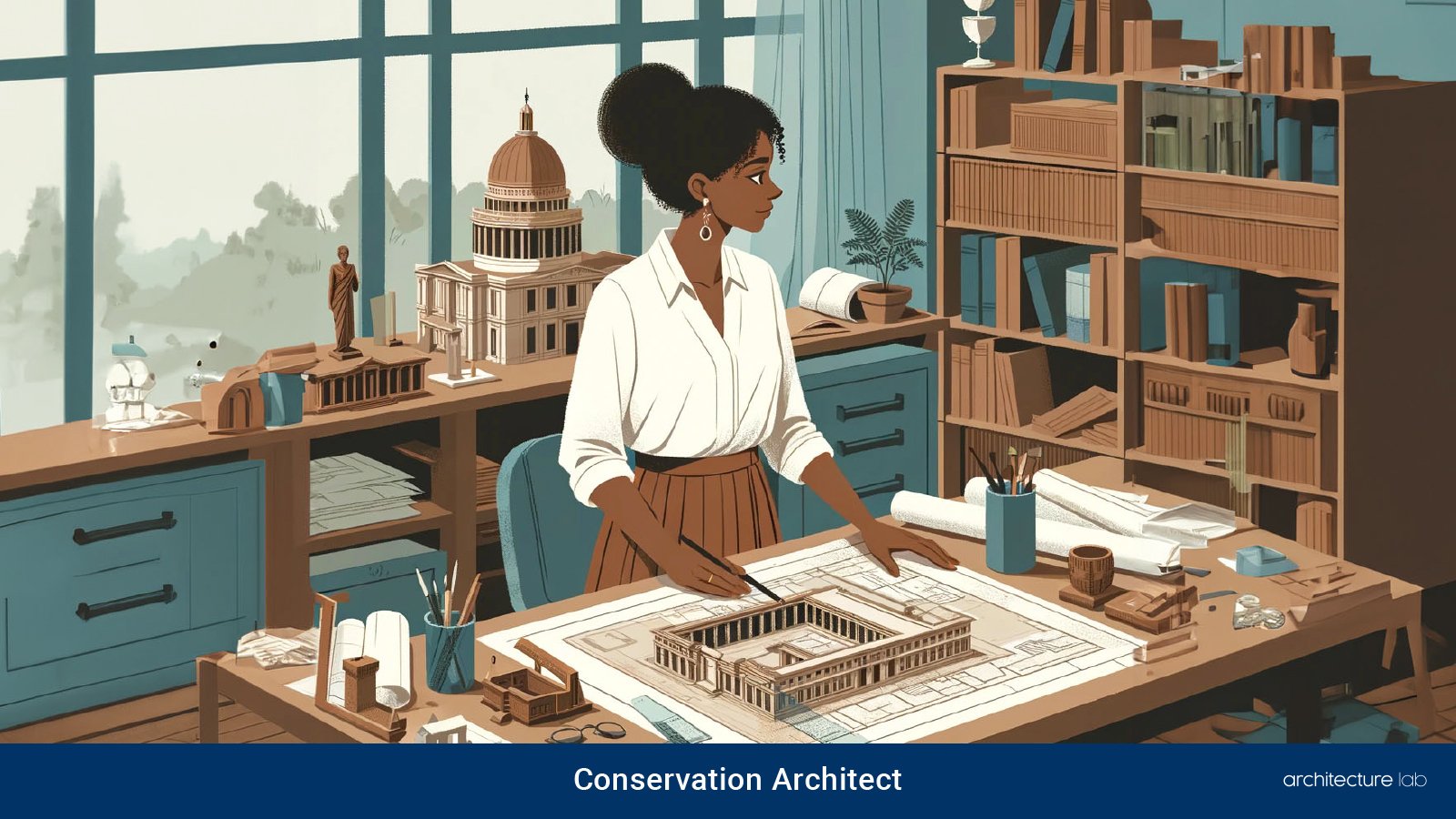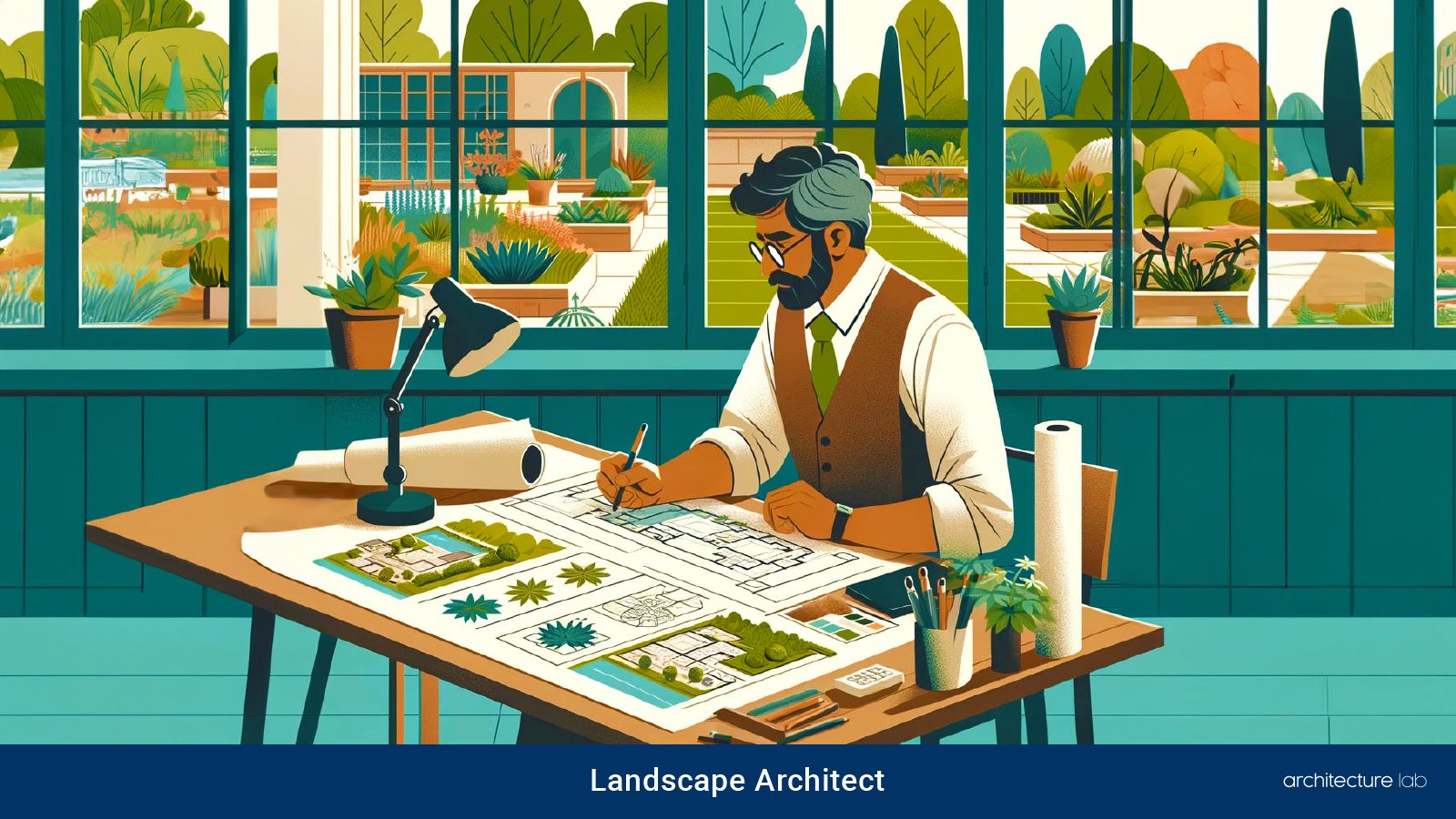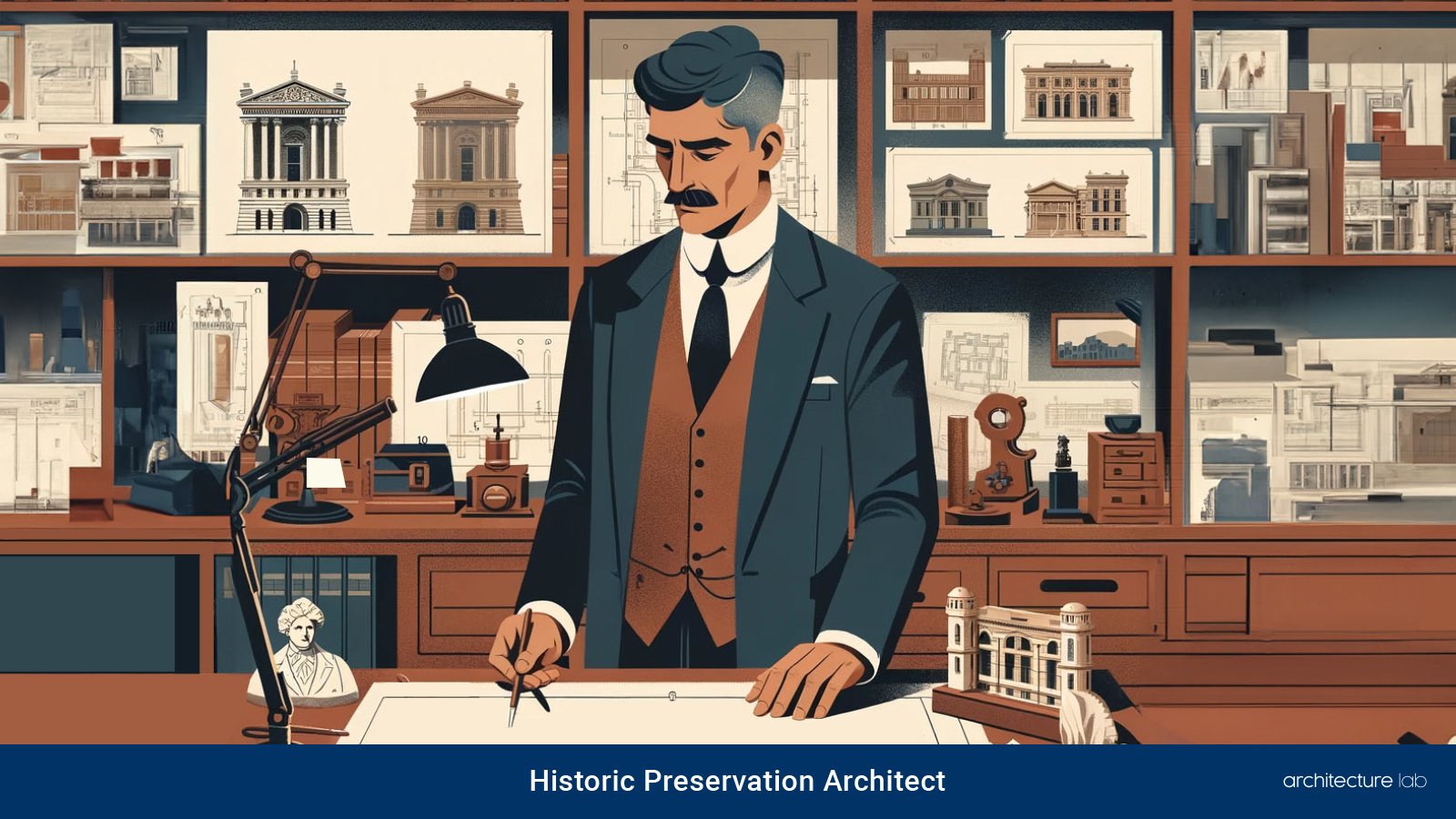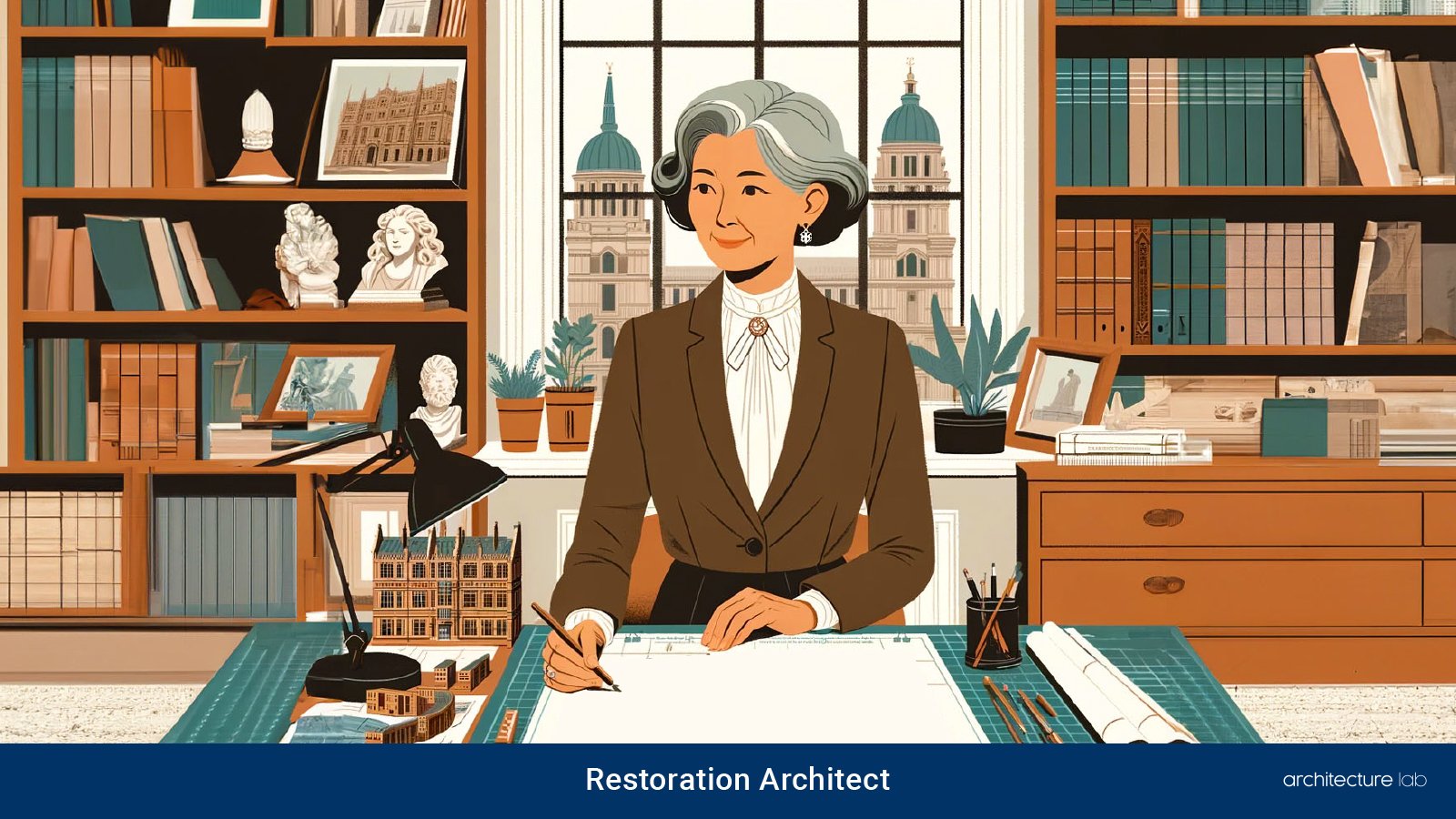Architects are professionals who design and plan buildings and other structures. They are responsible for creating functional, safe, sustainable, and aesthetically pleasing spaces. Architects also collaborate with engineers, contractors, clients, and other stakeholders to ensure the project meets the requirements and expectations. The role of architects is crucial for the development of society and the environment. Architects can influence the quality of life, the culture, and the economy of a place through their designs. They can also address the present and future challenges and opportunities, such as urbanization, climate change, social justice, and innovation. To become an architect, one needs to have a combination of skills, knowledge, and creativity. Architects must have a strong mathematics, science, art, and technology background. They must also have a keen eye for detail, a good sense of space, and a big-picture vision. Architects must communicate effectively, work in teams, and solve problems. They must follow their profession’s ethical and legal standards and respect the needs and values of their clients and the public.
Listed below are the types of architects and careers:
- Commercial Architect: Commercial architects specialize in designing buildings and spaces for commercial purposes, such as offices, retail stores, and hospitality establishments. They collaborate with clients to understand their business needs and create functional and visually appealing designs that meet building codes and regulations. Careers in commercial architecture offer opportunities to work on large-scale projects, collaborate with interdisciplinary teams, and contribute to urban development. Commercial architects may be involved in site analysis, space planning, interior design, and project management. Their work creates efficient and attractive spaces that support businesses and enhance the built environment.
- Residential Architect: Residential architects focus on designing homes and residential buildings, including single-family houses, apartments, and condominiums. They work closely with clients to understand their lifestyle preferences, budget constraints, and site requirements to create personalized and functional living spaces. Careers in residential architecture involve designing floor plans, selecting materials, coordinating with contractors, and ensuring compliance with building codes. Residential architects contribute to creating safe, comfortable, and aesthetically pleasing homes that meet the needs and aspirations of individuals and families. Their work spans from small-scale renovations to large-scale housing developments.
- Sustainable/Green Design Architect: Sustainable architects specialize in incorporating environmentally friendly principles into their designs to minimize the ecological impact of buildings. They integrate energy-efficient systems, renewable materials, and sustainable construction practices to reduce resource consumption and promote sustainability. Careers in sustainable architecture are focused on creating environmentally conscious designs that prioritize energy efficiency, water conservation, and indoor environmental quality. Sustainable architects may pursue certifications such as LEED (Leadership in Energy and Environmental Design) to demonstrate their expertise in sustainable design. Their work reduces carbon footprints, promotes renewable energy, and creates healthier built environments.
- Urban Designer: Urban designers focus on planning and designing the physical layout and organization of urban areas, including streets, parks, and public spaces. They collaborate with city planners, architects, and community stakeholders to create functional, aesthetically pleasing, and sustainable urban environments. Careers in urban design involve analyzing site conditions, conducting research, developing master plans, and implementing design guidelines. Urban designers contribute to shaping cities and improving the quality of urban life by creating pedestrian-friendly streetscapes, vibrant public spaces, and efficient transportation systems. Their work considers social, economic, and environmental factors to develop inclusive and livable urban spaces.
- Industrial Architect: Industrial architects design buildings and facilities for industrial purposes, such as factories, warehouses, and manufacturing plants. They focus on creating functional and efficient spaces that optimize workflow, accommodate specialized equipment, and meet safety regulations. Careers in industrial architecture involve understanding industrial processes, collaborating with engineers, and designing spaces that support productivity and operational needs. Industrial architects may be interested in site selection, space planning, environmental considerations, and logistics. Their work contributes to developing industrial infrastructure that facilitates production, storage, and distribution.
1. Commercial Architect
A commercial architect is a licensed professional who designs and implements buildings and structures for commercial and non-residential use, such as retail outlets, offices, factories, shopping centers, hospitals, hotels, and sports or recreation facilities. A commercial architect’s main task is to create functional and aesthetically pleasing spaces that meet the needs and preferences of their clients. They also oversee the construction process and ensure the project complies with the relevant codes, regulations, and standards. Commercial architects work with designers, engineers, contractors, and other specialists to deliver the project on time and within budget.
A commercial architect studies architecture, the art, and science of designing and constructing buildings and other physical structures. Architecture involves various aspects, such as history, theory, design, technology, materials, environment, and culture. Commercial architects apply their knowledge and skills to create solutions for specific commercial purposes and contexts. To become a commercial architect, one must have a bachelor’s degree in architecture, which usually takes five years to complete. Some universities offer a master’s degree in architecture, which can take one to two years to finish. After graduating, one must complete an internship program, which typically lasts three years, and pass the Architect Registration Exam (ARE), a series of tests that assess one’s competence and knowledge in architecture.

A commercial architect can land various jobs in the architecture industry, depending on their experience, skills, and interests. Some possible job titles are project architect, design architect, and senior architect. Firstly, a project architect is responsible for managing and coordinating the design and construction of a specific project. They communicate with the client, the contractors, and the consultants and ensure that the project meets the quality, cost, and schedule requirements. Secondly, a design architect is responsible for creating a project’s conceptual and schematic design. They develop the design vision, the layout, the style, and the appearance of the project. They also prepare the drawings, models, and presentations to communicate the design to the client and the team. Lastly, senior architect: A senior architect is a leader and a mentor in an architectural firm. They oversee the work of other architects and designers and provide guidance and feedback. They also handle a project’s complex and challenging aspects, such as technical issues, code compliance, and client relations.
The average salary of a commercial architect varies depending on the location, the experience, the education, and the employer. The salary of a commercial architect in the United States is $131,322 (€119,503.02, £114,250.14), meanwhile, the commercial architect’s salary in Europe is $87,200 (€80,000, £69,600). The best schools or universities for becoming a commercial architect are Massachusetts Institute of Technology (MIT) in the United States, University College London (UCL) in the United Kingdom, Delft University of Technology in the Netherlands, ETH Zurich in Switzerland, and Harvard University in the United States.
2. Residential Architect
A residential architect is a professional who designs and plans houses and residential buildings. They work closely with clients to understand their needs and preferences and create functional and aesthetically pleasing designs. To develop practical and safe living spaces, residential architects consider space utilization, building codes, and construction materials. They may also guide interior layout, lighting, and other elements contributing to a comfortable and efficient home. The responsibilities of a residential architect are designing and planning houses and residential buildings, including collaborating with clients to understand their needs and preferences, creating functional and safe designs, considering building codes and regulations, selecting appropriate construction materials, and ensuring efficient use of space. They may also guide interior layout, lighting, and other elements contributing to a comfortable and practical home. Residential architects may oversee the construction process to ensure compliance with the design plans. The primary goal is to create well-designed residential spaces that meet the requirements and vision of the clients.

The types of buildings that residential architects commonly design are single-family homes, townhouses, apartment complexes, and condominiums. They specialize in creating livable and functional spaces for individuals and families. These types of buildings are designed to provide private and comfortable living environments that meet the specific needs and preferences of the residents. The salary of a residential architect in the United States is $100,000 (€91,000, £87,000) per year, or $48 (€43.68, £41.76) per hour. In comparison, the residential architect’s salary in Europe is lower, which is $81,750 (€75,000, £65,250) per year, or $39.24 (€36, £31.32) per hour. To become a residential architect, one can study at various educational institutions that offer accredited architecture programs. Universities and colleges worldwide provide architectural education at undergraduate and graduate levels. Some well-known institutions for studying residential architecture include the Architectural Association School of Architecture in London, the Harvard Graduate School of Design in the United States, and the Royal Melbourne Institute of Technology in Australia. These institutions offer comprehensive architectural curricula that cover design principles, architectural history, building technology, and professional practice. Students also gain practical experience through design studios, internships, and collaborative projects. Upon completing the program and meeting the necessary licensure requirements, graduates can pursue a career as residential architects.
3. Sustainable/Green Design Architect
A Sustainable or Green Design Architect specializes in creating environmentally conscious and energy-efficient buildings and structures. They incorporate sustainable practices and principles into their designs to reduce the negative environmental impact and promote a healthier and more sustainable future. A sustainable or Green Design Architect focuses on designing structures that minimize energy consumption, utilize renewable resources, and encourage efficient use of materials. They employ passive solar design, natural ventilation, and energy-efficient systems to reduce the building’s carbon footprint and maximize its sustainability. Their designs also consider water efficiency, waste reduction, and environmentally friendly materials. To become a sustainable or green design architect, one typically studies architecture at a university or college. They learn about architectural principles, design techniques, and building systems. They delve into courses related to sustainability, green building practices, energy efficiency, and environmental impact assessment. These studies give them the knowledge and skills to incorporate sustainable design principles into their architectural projects effectively.

To pursue a Sustainable or Green Design Architect career, one generally needs a professional degree in architecture, such as a Bachelor of Architecture (BArch) or a Master of Architecture (MArch). These degrees provide a comprehensive understanding of architectural design and enable individuals to obtain licensure as architects. Acquiring green building and sustainability certifications, such as LEED (Leadership in Energy and Environmental Design), further enhances their qualifications as Sustainable or Green Design Architects. As a sustainable or green design architect, one can work at architectural firms specializing in sustainable design, engineering firms, or governmental organizations focused on environmental initiatives. They can also work as independent consultants, providing expertise and guidance on sustainable design practices to clients. They may contribute to research and development efforts in sustainable architecture.
4. Urban Designer
An urban designer is a professional who plans and designs the physical aspects of cities, towns, and other urban environments. These designers create outlines for buildings, parks, transportation centers, neighborhoods, and waterways. They can improve existing spaces or build new facilities and developments. An urban designer’s work is related to architecture in many ways. These designers collaborate with architects, engineers, landscape architects, and planners to shape the urban form and function. They also consider the architectural style, character, and quality of buildings and spaces in their design proposals. An urban designer studies various topics related to urban design, such as history, theory, methods, analysis, and practice. These designers may also study specific issues or themes, such as sustainability, social justice, resilience, or innovation. They use different tools and techniques, such as mapping, modeling, drawing, and visualization, to communicate and test their design ideas.
To become an urban designer, one usually needs a bachelor’s degree and a master’s degree in a relevant field, such as urban planning, landscape architecture, or design. Some of these designers may also have a doctoral degree or a professional certification. They must also have skills and knowledge in design, research, communication, and collaboration. An urban designer can find jobs in various sectors and settings, such as government agencies, private firms, non-profit organizations, academic institutions, or international agencies. These designers may work on projects of different scales and types, such as master plans, urban regeneration, public space design, urban policy, or urban research. The average annual salary of an urban designer in the United States is $72,240 (€64,000, £54,000). There are many schools or universities that offer urban design programs or courses around the world. Some of the best urban design schools or universities are Harvard University, Massachusetts Institute of Technology, University of California Berkeley, University College London, and ETH Zurich.
5. Industrial Architect
An industrial architect designs and plans industrial facilities, such as factories, warehouses, and power plants. They combine their knowledge of architecture, engineering, and construction to create functional and efficient spaces that meet the needs of the production process. An industrial architect’s work is related to architecture in many ways. They use architectural principles and techniques to create layouts, elevations, and specifications. They also consider their design’s aesthetic, environmental, and ergonomic aspects. They use computer-aided design (CAD) software and 3D modeling tools to visualize and communicate their ideas.

To become an industrial architect, one must study industrial design, a branch of architecture that focuses on designing products, systems, and services for industrial applications. Industrial design courses cover materials, technologies, manufacturing methods, ergonomics, sustainability, and user-centered design. The minimum degree requirement for an industrial architect is a bachelor’s degree in industrial design, architecture, or a related field from a program accredited by the National Architecture Accrediting Board (NAAB). Some industrial architects may also pursue a master’s degree or a doctorate in industrial design or architecture to gain more specialized knowledge and skills.
An industrial architect can land various jobs in different sectors and industries. They can work as consultants, designers, project managers, or researchers for architectural firms, engineering companies, manufacturing corporations, government agencies, or academic institutions. They can also work as freelancers or entrepreneurs and start their own design studios or businesses. The average salary of an industrial architect in the United States is $100,475 (€88,700, £75,900) per year or $48.31 (€42.60, £36.50) per hour.
6. Conservation Architect
A conservation architect is a professional specializing in preserving and restoring historic buildings and structures. They have expertise in assessing the condition of heritage sites, developing conservation plans, and implementing strategies to protect and maintain them. Conservation architects work closely with stakeholders, such as government agencies, property owners, and community organizations, to ensure that historical significance is preserved while accommodating modern use and safety standards. They utilize their knowledge of architectural history, materials, and techniques to guide the conservation process. Conservation architects play a crucial role in safeguarding cultural heritage for future generations. The responsibilities of a conservation architect include assessing the condition of historic buildings and structures, developing conservation plans, and overseeing their implementation. They conduct thorough inspections to identify vulnerabilities and deterioration and propose appropriate restoration and preservation strategies. Conservation architects collaborate with stakeholders to ensure conservation projects align with historical significance and regulatory requirements. They may also supervise construction work, ensuring it adheres to conservation principles and uses appropriate materials and techniques. Conservation architects provide expertise and guidance on maintaining the integrity and authenticity of heritage sites, contributing to the long-term preservation of cultural heritage.

Conservation architects commonly design and work on various historic buildings and structures. These can include heritage sites such as castles, palaces, churches, temples, mosques, historic houses, museums, government buildings, and other culturally significant structures. They may also be involved in preserving and adaptively reusing industrial buildings, bridges, monuments, and archaeological sites. The salary of a conservation architect can vary depending on factors such as experience, location, and employer. In the United States, a conservation architect’s salary is $80,000 (€72,800, £69,600), while in Europe, the average annual salary is $54,500 (€50,000, £43,500).
Individuals can study at various educational institutions worldwide to become conservation architects. Many universities offer specialized programs in conservation architecture or related fields, such as Historic Preservation or architectural conservation. Examples of reputable institutions include the University of Cambridge (United Kingdom), the University of Pennsylvania (United States), the Polytechnic University of Milan (Italy), the École de Chaillot (France), and the University of Melbourne (Australia). These programs provide a combination of theoretical knowledge and practical skills necessary for working in conservation architecture. Students learn about building conservation principles, materials science, heritage management, and architectural history. Some programs may also offer opportunities for hands-on experience through fieldwork or internships.
7. Landscape Architect
A landscape architect designs and plans outdoor spaces to achieve aesthetic, environmental, and functional goals. They work on various projects, such as parks, gardens, recreation areas, residential properties, and commercial developments. A landscape architect’s role in architecture is to collaborate with other professionals, such as architects and engineers, to ensure their designs are safe, practical, and effective. They also consider natural features, topography, climate, and human needs and preferences when designing outdoor spaces.

A landscape architect studies topics related to landscape architecture, such as landscape design and research, design communication, history and theory, professional practice, planning, and urban design, landscape technology and utilities, and environmental science. A landscape architect can have different jobs depending on their skills and interests. Some common job titles are landscape designer, landscape planner, landscape manager, landscape consultant, landscape researcher, landscape educator, and landscape policy maker.
To become a landscape architect, one must have at least a bachelor’s degree from an accredited school, internship experience, and pass the Landscape Architect Registration Examination, where the requirements may vary by state and country. There are many schools and universities in the US and Europe that offer landscape architecture programs. Some of the best are Harvard University, University of Copenhagen, University of Sheffield, Leibniz Universitat Hannover, University of Gloucestershire, Leeds Metropolitan University, University of California Berkeley, Cornell University, ETH Zurich, and Wageningen University.
8. Interior Architect
An interior architect is a professional who designs and plans the interior spaces of buildings. They work with clients to create functional and aesthetically pleasing spaces, considering the space’s purpose, the occupants’ needs, and the building’s overall design. An interior architect’s role is related to architecture in several ways. They focus on the structural elements, spatial planning, and the integration of the interior design with the overall architectural design of the building. They must also follow building codes, safety regulations, and accessibility guidelines and collaborate with other professionals, such as architects and engineers, to ensure that the design is cohesive and meets all requirements.

An interior architect studies various architecture-related topics, such as design theory, history, methods, materials, lighting, acoustics, and sustainability. They also learn to use computer software, such as computer-aided design (CAD) and building information modeling (BIM), to create technical drawings and specifications. They develop their creative and artistic skills and communication and project management skills. To become an interior architect, one typically needs a bachelor’s degree in interior architecture, interior design, or a related field. Some programs may also require a portfolio or design project as part of the application process. After completing the degree, one must also obtain a license to practice as an interior architect in most states. It requires passing the National Council for Interior Design Qualification (NCIDQ) exam, which tests knowledge of design theory, building codes, and professional practice.
An interior architect can have various types of jobs, depending on their area of specialization and the type of project they work on. Some examples are independent interior design consultants and entrepreneurs for individual residential or commercial clients, in-house designers for commercial retail and hotel chains, or interior architects for architecture firms. They can work on projects such as homes, apartments, offices, retail stores, restaurants, hotels, museums, schools, hospitals, and more. Many schools or universities offer interior architecture or interior design programs in the US or Europe. Some of the best ones, according to various rankings, are the Massachusetts Institute of Technology (MIT) in Cambridge, United States, Delft University of Technology in Delft, Netherlands, UCL in London, United Kingdom, ETH Zurich – Swiss Federal Institute of Technology in Zürich, and Switzerland, Harvard University in Cambridge, United States.
9. Extreme Architect
An extreme architect is a professional specializing in designing and constructing buildings and structures that push the boundaries of conventional architecture. They create innovative, daring designs that challenge traditional norms and embrace unconventional materials and construction techniques. An extreme architect is known for their bold and adventurous approach, incorporating cantilevers, intricate geometries, and sustainable features. They strive to create functional yet visually striking spaces that evoke a sense of awe and wonder. Their services are sought by clients willing to invest in unique and boundary-pushing architectural experiences. The responsibilities of an extreme architect include designing and planning architectural projects that push the boundaries of conventional design, incorporating innovative and daring elements. They collaborate with clients to understand their needs and vision and develop unique, boundary-pushing concepts. They create detailed architectural drawings and models, ensuring the designs are structurally sound and meet building codes and regulations. Extreme architects also oversee the construction process, working closely with contractors and engineers to ensure the successful realization of their designs.

Extreme architects commonly design various buildings, including residential homes, commercial complexes, cultural institutions, and public spaces. They are often involved in projects that require unique and innovative designs, such as avant-garde museums, futuristic office buildings, cutting-edge research facilities, and eco-friendly structures. Extreme architects are sought after for their ability to create visually striking and unconventional spaces that challenge traditional architectural norms. They may also work on renovations and adaptive reuse projects, transforming existing structures into bold and contemporary spaces. The scale and complexity of the buildings designed by extreme architects may vary, ranging from small-scale renovations to large-scale developments with significant budgets.
An extreme architect’s salary can vary depending on factors such as experience, location, and the scale of their projects. Extreme architects in the United States can earn $80,000 (€72,800, £69,600) per year. In Europe, the salary range for extreme architects is $70,850 (€65,000, £56,550) per year. To become an extreme architect, individuals can pursue their studies at various universities and institutions worldwide. Famous institutions offering architecture programs include the Massachusetts Institute of Technology (MIT) in the United States, the Architectural Association School of Architecture (AA) in the United Kingdom, Delft University of Technology in the Netherlands, ETH Zurich in Switzerland, and the University of Sydney in Australia. These institutions provide comprehensive architecture programs that cover design principles, construction techniques, sustainability, and advanced technologies. Prospective students can choose from undergraduate and graduate programs that align with their career goals and aspirations as extreme architects.
10. Lighting Architect
A lighting architect is a professional who specializes in designing and implementing lighting systems for various architectural spaces. They possess expertise in analyzing the specific requirements of a building or environment and creating lighting plans that enhance functionality, safety, and aesthetic appeal. Lighting architects collaborate with interior designers and electrical engineers to ensure the lighting design aligns with the project’s vision. They consider natural light, energy efficiency, and the desired atmosphere to create effective lighting solutions. Lighting architects may work on projects ranging from residential homes to commercial buildings, aiming to optimize lighting quality and create comfortable environments for occupants. The responsibilities of a lighting architect include analyzing lighting requirements, designing lighting plans, selecting appropriate fixtures, and implementing lighting systems for architectural spaces. They collaborate with architects, interior designers, and electrical engineers to ensure the lighting design aligns with the overall project vision. Lighting Architects consider natural light, energy efficiency, and desired ambiance to create effective lighting solutions. They may also conduct lighting calculations, prepare technical documentation, and supervise the installation and testing of lighting systems.

Lighting architects commonly design various buildings, including residential homes, commercial spaces such as offices, retail stores, restaurants, and public buildings like museums, theaters, and hospitals. They may also work in outdoor spaces such as parks, plazas, and landscapes. Lighting architects aim to optimize lighting quality and create comfortable environments for occupants in diverse architectural settings. A Lighting architect’s salary varies depending on the country, experience, and type of employment. , the average annual salary for a lighting architect in the United States is $80,000 (€72,800, £69,600), while in Europe, it is $49,050 (€45,000, £39,150).
To become a lighting architect, one can study at various educational institutions that offer programs in architecture, lighting design, or related fields. Universities and colleges worldwide provide undergraduate and graduate architecture and lighting design programs that equip students with the necessary knowledge and skills. Some prominent institutions offering such programs include the Royal College of Art in London, United Kingdom, where students can pursue a Master’s in Lighting Design; the Parsons School of Design in New York City, United States, which offers a Bachelor of Fine Arts in Architectural Lighting Design; and the Technical University of Munich in Munich, Germany, where students can enroll in a Bachelor or Master program in Lighting Design and Technology. Some specialized institutions and organizations offer short-term courses, workshops, and certifications in lighting design, allowing professionals to enhance their skills or individuals to gain foundational knowledge in the field.
11. Historic Preservation Architect
A historic preservation architect is a professional who helps preserve old buildings that have historical value. They repair the structure, bring the building up to code, and take measures to ensure its longevity. They also plan renovations that meet guidelines set out by organizations like the National Register of Historic Places. A historic preservation architect’s work is related to architecture as they use architectural expertise and historical research to ensure the longevity and authenticity of structures. They also design harmonious new development that respects the site’s cultural heritage. A historic preservation architect studies the history and theory of historic preservation, building conservation, preservation planning, heritage interpretation, and cultural resource management. They also learn practical skills in building materials and construction on landmark sites.

To become a historic preservation architect, one needs a degree in architecture focusing on historic preservation. Most employers prefer architects with a master’s degree in architecture or a specialized graduate degree in historic preservation. They also need experience building restoration and using relevant computer programs like AutoCAD. A historic preservation architect can have various jobs, such as working for private architectural firms, city planning departments, state historic preservation offices, federal cultural resources divisions, and nonprofit agencies. They can also work as consultants, educators, researchers, or advocates for heritage conservation. Some of the best schools or universities for becoming a historic preservation architect in the US or Europe are the University of Pennsylvania School of Design, the University of Oregon School of Architecture and Environment, the University of Virginia School of Architecture, and the Pratt Institute School of Architecture.
12. Restoration Architect
A restoration architect, also known as a conservation architect, is a professional who specializes in the preservation, repair, and restoration of historic buildings and structures. Their role involves assessing the condition of the architectural heritage, developing conservation plans, and overseeing the implementation of restoration projects. They utilize their expertise in architectural design, materials science, and historical research to ensure that the restoration work respects the original character and integrity of the structure. Restoration architects work closely with clients, historians, artisans, and construction teams to safeguard cultural heritage and maintain its authenticity. Their goal is to prolong historic buildings’ lifespan and contribute to cultural identity preservation. The responsibilities of a restoration architect include assessing the condition of historic structures, developing conservation plans, overseeing restoration projects, and ensuring the preservation of cultural heritage. They conduct detailed inspections to identify structural issues, deterioration, and damage. They collaborate with clients, historians, and construction teams to develop appropriate restoration strategies that respect the original design and materials. Restoration architects research historical documentation to inform their decision-making and ensure the accuracy of the restoration work. They also monitor construction activities, review specifications, and ensure compliance with conservation guidelines. Their goal is to protect and extend the lifespan of historic buildings while maintaining their historical significance and cultural value.

Restoration architects commonly design and work on various types of historic buildings, including but not limited to churches, cathedrals, palaces, castles, museums, government buildings, stately homes, monuments, and other architectural landmarks. These structures often possess significant historical, cultural, and architectural value, requiring specialized attention to their preservation and restoration. Restoration architects apply their expertise to ensure the conservation of these buildings while respecting their original design, materials, and historical significance. They work closely with clients, historians, and skilled craftsmen to safeguard the integrity and authenticity of these important cultural assets. A restoration architect’s salary varies depending on the country, experience, and type of employment. The average annual salary for a restoration architect in the United States is $80,000 (€72,800, £69,600), while in Europe it is $54,500 (€50,000, £43,500).
To become a restoration architect, individuals can pursue their studies at various academic institutions and universities that offer programs or courses in architectural conservation, historic preservation, or restoration architecture. These programs provide specialized education and training in the field, equipping students with the knowledge and skills necessary for a career in restoration architecture. Some known institutions offering such programs include universities in Europe, such as the University of Bath (United Kingdom), Università IUAV di Venezia (Italy), and ENSAV La Cambre (Belgium), and institutions in the United States, such as Columbia University, University of Pennsylvania, and Savannah College of Art and Design. There are other educational organizations and professional associations that offer workshops, seminars, and certification programs focused on specific aspects of restoration architecture.
13. Urban Planner
An urban planner is a professional who works to create and implement plans for the development of cities, towns, and other urban areas. They use their knowledge of land use, zoning laws, transportation systems, and other urban infrastructure to help guide the growth and development of communities. They often work with government officials, developers, and community members to create plans that meet the community’s and the environment’s needs. Urban planners have a solid connection to architecture, as they both deal with the design and use of space. They may collaborate with architects to prepare and finalize plans for buildings and public areas; however, they have different roles and perspectives. Urban planners decide what can be built, where and how outdoor areas will be used, and architects create the actual design. Urban planners focus on the big picture of community needs and the impact on surrounding areas, while architects are primarily concerned with their clients’ needs.

To become an urban planner, one usually needs a master’s degree in urban planning or a related field. The most common areas of study are urban planning, geography, architecture, and environmental science. Some urban planners may also have a bachelor’s degree in urban studies or a similar discipline. Urban planners may also need a license or certification, depending on the state or country they work in. Urban planners can work for employers such as local governments, private firms, non-governmental organizations, or academic institutions. Some of the best schools or universities for becoming an urban planner in the US or Europe are University College London, the University of Manchester, Utrecht University, Texas A&M University-College Station, and the University of California-Irvine.
14. Building Surveyor
A building surveyor is a professional who assesses the quality and condition of buildings and advises on options for repair, maintenance, or restoration. They also deal with legal and planning issues, health and safety, and property alterations. A building surveyor’s role is related to architecture in that they work with architects and other engineers to coordinate measurements, evaluate designs, and ensure compliance with building regulations and standards. They may also be involved in developing and preserving buildings with historical or architectural importance.
A building surveyor studies surveying, construction, civil engineering, building engineering, property law, building pathology, project management, and sustainability. They also learn how to use various surveying equipment and software tools. A building surveyor can have multiple jobs depending on their specialization and experience. Some examples are residential building surveyor, commercial building surveyor, historic building surveyor, building control surveyor, and construction project manager.
To become a building surveyor, one must have a degree in a relevant subject accredited by the Royal Institution of Chartered Surveyors (RICS) or a similar professional body. Alternatively, one can complete an apprenticeship or a graduate trainee scheme with a construction company or a surveying firm. Some schools or universities in the US or Europe that offer RICS-accredited courses in building surveying or related subjects are Michigan Technological University, University of Maine, DePaul University, Southern Illinois University Edwardsville, University of Reading, and University College London.
15. Structural Engineer
A structural engineer designs and evaluates the integrity and safety of buildings, bridges, towers, and other structures. They apply their knowledge of physics, mathematics, and engineering principles to create robust and durable structures that can withstand various loads and forces. A structural engineer works closely with architects to translate their conceptual designs into feasible and structurally sound plans. They also collaborate with construction teams and other engineers to ensure the quality and efficiency of the building process. A structural engineer may inspect and assess existing structures for damage, repair, or renovation.
A structural engineer studies topics such as structural analysis, structural design, mechanics of materials, engineering mathematics, engineering physics, and engineering software. They also learn about different types of structures, materials, loads, and codes. A structural engineer may specialize in a specific field, such as bridges, buildings, dams, or offshore structures. A structural engineer can have various jobs depending on their interests, skills, and experience. Some common job titles for structural engineers are structural design engineer, structural analysis engineer, structural project engineer, structural consultant, structural inspector, structural researcher, and structural professor. A structural engineer can work for engineering firms, construction companies, government agencies, research institutions, or academic institutions.
To become a structural engineer, one must have a bachelor’s degree in civil engineering, structural engineering, or a related field. They must also pass the Fundamentals of Engineering (FE) and Professional Engineering (PE) exams to obtain a license to practice in their state. Some structural engineers may pursue a master’s or doctoral degree to gain advanced knowledge and skills. Some of the best schools or universities for becoming a structural engineer in the US or Europe are Stanford University, Massachusetts Institute of Technology, University of California – Berkeley, University of Michigan – Ann Arbor, Georgia Institute of Technology, and Georgia Institute of Technology, ETH Zurich, Delft University of Technology, University of Cambridge, and Technical University of Munich in Europe.
16. Architectural Historian
An architectural historian is a person who studies and writes about the history of architecture and is regarded as an authority on it. An architectural historian can do various tasks related to architecture, such as advising owners and stewards on how to preserve the historic fabric of a building, researching the building methods and materials or the impact on the cultural landscape, mapping the evolution of the building to define or recreate its architectural history, or educating and entertaining the public about historic buildings.
An architectural historian studies different aspects of architecture, such as the styles, designs, functions, meanings, influences, and contexts of buildings and structures and the architects, builders, patrons, and users who created and used them. An architectural historian can have different jobs, depending on their specialty and interest. Some typical jobs are professor, lecturer, researcher, or coordinator in architectural history at universities and research organizations; consultant, writer, or editor for architectural publications, journals, or magazines; curator, guide, or interpreter at museums, historic sites, or national parks; planner, administrator, or advocate for preservation programs, policies, or projects at government agencies or nonprofit organizations; or advisor, director, or manager for restoration, renovation, or conservation of historic buildings or structures at private firms or institutions.
To become an architectural historian, one usually needs a bachelor’s degree in a relevant field, such as art history, architecture, archaeology, history, or urban studies; however, most employers prefer a master’s degree or a Ph.D. in architectural history, art history, historic preservation, or a closely related field, with coursework in architectural history. Some also require professional experience, research, publication, or accreditation in architectural history. There are many schools or universities that offer programs or courses in architectural history, but some of the best ones in the US or Europe are Harvard University, University of Virginia, Columbia University, University of Texas at Austin, Washington University in St. Louis, Boston Architectural College, Savannah College of Art and Design, University of Houston, Yale University, University of Cambridge, University of Oxford, University College London, University of Edinburgh, Leiden University, and ETH Zurich.
17. Artist
An artist is a person who creates art using conscious skill and creative imagination. Art can include painting, drawing, sculpture, photography, film, music, and more. An artist can do various architecture-related tasks, such as designing buildings or spaces, creating models or sketches, collaborating with architects or engineers, or producing artworks that reflect or critique architectural concepts. An artist can study different aspects of architecture, such as the history, theory, styles, functions, meanings, influences, and contexts of buildings and structures, and the architects, builders, patrons, and users who created and used them.
An artist can have different jobs, depending on their specialty and interest. Some typical jobs are architect, interior designer, landscape architect, urban planner, graphic designer, illustrator, animator, art director, art teacher, art critic, or art curator. To become an artist, one usually needs a bachelor’s degree in a relevant field, such as art, design, architecture, or a related discipline; however, some artists may not have a formal education but rely on their talent, experience, portfolio, or reputation to pursue their artistic careers. There are many schools or universities that offer programs or courses in art and architecture, but some of the best ones in the US or Europe are Royal College of Art, University of the Arts London, Parsons School of Design, Rhode Island School of Design, Massachusetts Institute of Technology, Politecnico di Milano, Aalto University, Glasgow School of Art, School of the Art Institute of Chicago, and Pratt Institute.
18. Architect Research
An Architect researcher is a professional who conducts original investigations in architecture to generate new knowledge, insights, and understanding based on the methods and tools of the discipline. An architect researcher does various activities related to architecture, such as exploring new design concepts, developing innovative solutions, testing new materials, evaluating existing buildings, and contributing to advancing architectural theory and practice. An architect researcher studies design processes, sustainability, urbanism, history, culture, technology, and social aspects of architecture. They use various research methods, such as surveys, interviews, observations, experiments, simulations, and case studies, to collect and analyze data and produce findings.
Architect researchers can have different jobs, such as academic researchers, design consultants, project managers, policymakers, or educators. To become an architect researcher, one needs to have a degree in architecture, preferably a master’s or a doctoral degree. A master’s degree in architecture (MArch) is a professional degree that prepares students for architectural practice and research. A doctoral degree in architecture (PhD) is a research degree that focuses on a specific area of inquiry and requires a dissertation. Some of the best schools or universities for becoming an architect researcher are Massachusetts Institute of Technology (MIT), Delft University of Technology, UCL, ETH Zurich, and Harvard University. These institutions offer high-quality education and research opportunities in various aspects of architecture.
19. Architecture Professor
An architecture professor teaches architectural design and related subjects at a college or university. They may teach general principles of architecture and design or focus on a specialty, such as interior design, landscape architecture, or environmental design. An architecture professor does various architecture-related tasks, such as preparing and delivering lectures, conducting research, supervising students’ projects, advising students, grading assignments and exams, publishing papers and books, attending academic conferences, and serving on academic committees.
An architecture professor studies different aspects of architecture, such as history, theory, criticism, technology, sustainability, urbanism, culture, and aesthetics. They may also study specific topics within their specialty, such as heritage conservation, environmental management planning, or landscape architecture. An architecture professor can have different jobs depending on their qualifications, experience, and interests. Some possible jobs are academic administrators, such as dean, department chair, or program director. Researcher, such as principal investigator, project leader, or consultant. Practitioners, such as architects, designers, or planners. Author, such as editor, writer, or reviewer, or Educator, such as trainer, mentor, or tutor.
An architecture professor typically needs a doctoral degree in architecture or a related field, such as urban planning, environmental design, or engineering. Depending on the country and state where they work, they may also need a professional license or certification. They need teaching experience, research skills, and publications in their field. The best schools or universities for becoming an architecture professor are Massachusetts Institute of Technology (MIT) in Cambridge, MA, USA, Harvard University in Cambridge, MA, USA, University College London (UCL) in London, UK, ETH Zurich in Zurich, Switzerland, and Delft University of Technology in Delft, Netherlands.
What types of architects are the most creative?
Listed below are the types of architects that are most creative:
- Commercial Architect: Commercial architects are highly creative in their work, constantly pushing the boundaries of design to create innovative and visually striking buildings for businesses and organizations. They specialize in designing functional, aesthetically pleasing spaces aligned with the client’s brand image, often incorporating unique features and materials. Their abstract work involves creating cutting-edge structures that capture attention and leave a lasting impression on visitors and stakeholders. Commercial architects can work on large-scale projects such as office buildings, shopping malls, and hotels, allowing them to explore bold architectural concepts and experiment with different styles. Their creativity extends beyond the physical design, as they also consider factors such as sustainability, energy efficiency, and user experience to create holistic and impactful spaces.
- Sustainable/Green Design Architect: Sustainable or green design architects are known for their creativity in developing environmentally friendly and energy-efficient buildings. They employ innovative design strategies, such as passive solar design, green roofs, and renewable energy systems, to minimize the environmental impact of the structures they create. Their abstract work involves finding harmonious solutions that integrate the built environment with nature, often incorporating natural materials, daylighting, and efficient insulation systems. These architects are at the forefront of the green building movement, constantly exploring and implementing new technologies and techniques to create sustainable architecture. Their creative approach combines functionality, aesthetics, and environmental consciousness to deliver visually appealing and ecologically responsible buildings.
- Conservation Architect: Conservation architects demonstrate remarkable creativity in preserving and restoring historic buildings and structures. They deeply understand architectural history, materials, and construction techniques, allowing them to analyze and interpret existing structures with a creative perspective. Their abstract work involves finding innovative solutions to repair and conserve historic elements while ensuring the building’s integrity and authenticity. Conservation architects often must balance preserving historical features with incorporating modern amenities and functionality, requiring creative design interventions. Their creativity lies in blending the old harmoniously and the new, celebrating the architectural heritage while adapting it to contemporary needs.
- Landscape Architect: Landscape architects showcase their creativity in designing outdoor spaces seamlessly integrating with the natural environment. They deeply understand plants, terrain, and ecological systems, enabling them to create captivating and sustainable landscapes. Their abstract work involves conceptualizing and visualizing outdoor spaces, considering factors such as topography, climate, and human interaction. Landscape architects often employ artistic elements like plant selection, hardscape materials, and water features to create visually stunning and functional designs. Their creativity extends to transforming and enhancing the natural landscape, creating outdoor environments that evoke a sense of beauty, tranquility, and harmony.
- Restoration Architect: Restoration architects demonstrate creativity by breathing new life into deteriorated or damaged structures, preserving their historical and architectural significance. They possess a deep knowledge of historical building techniques, materials, and styles, allowing them to restore and recreate past elements accurately. Their abstract work involves analyzing existing conditions, researching historical records, and developing creative solutions to address structural issues while maintaining the building’s authenticity. Restoration architects often work with limited resources and challenging constraints, requiring creative problem-solving and adaptive reuse strategies. Their creativity lies in reimagining and reviving neglected buildings, restoring their former glory, and ensuring their cultural and architectural legacy endures.
What types of architects get the best salaries?
Listed below are the types of architects that get the best architect salaries:
- Landscape Architect: Landscape architects are highly creative, designing outdoor spaces seamlessly integrating with the natural environment. They possess a deep understanding of plants, terrain, and ecological systems, allowing them to create captivating and sustainable landscapes. Their abstract work involves conceptualizing and visualizing outdoor spaces, considering factors such as topography, climate, and human interaction. Landscape architects often employ artistic elements like plant selection, hardscape materials, and water features to create visually striking and functional designs. Their creativity lies in transforming and enhancing the natural landscape, creating outdoor environments that evoke a sense of beauty and harmony.
- Architectural Technologist: Architectural technologists showcase their creativity in the technical aspects of architectural design and construction. They possess a strong understanding of building materials, construction techniques, and building codes, allowing them to translate design concepts into detailed and feasible plans. Their abstract work involves finding innovative solutions to complex design challenges, such as integrating sustainable technologies and optimizing building performance. Architectural technologists often collaborate with architects and engineers to ensure the practical implementation of design ideas while adhering to budgetary and regulatory constraints. Their creativity lies in bridging the gap between design and construction, optimizing functionality and efficiency while maintaining aesthetic integrity.
- Architectural Designer: Architectural designers are known for their creativity in developing innovative and visually appealing architectural concepts. They possess a strong sense of aesthetics, form, and proportion, allowing them to create unique and cutting-edge designs. Their abstract work involves exploring various design options, experimenting with materials, and incorporating artistic elements to create visually striking spaces. Architectural designers often push the boundaries of conventional design, incorporating unconventional shapes, materials, and spatial arrangements. Their creativity lies in balancing functionality, aesthetics, and user experience to deliver visually captivating and functional designs.
- Preservation Architect: Preservation architects demonstrate creativity in preserving and restoring historic buildings and structures. They have a deep knowledge of architectural history, materials, and construction techniques, allowing them to analyze and interpret existing structures with a creative perspective. Their abstract work involves finding innovative solutions to repair and conserve historic elements while ensuring the building’s integrity and authenticity. Preservation architects often balance preserving historical features with incorporating modern amenities and functionality, requiring creative design interventions. Their creativity lies in blending the old harmoniously and the new, celebrating the architectural heritage while adapting it to contemporary needs.
- Green Building & Retrofit Architect: Green building and retrofit architects showcase their creativity in designing environmentally sustainable and energy-efficient structures. They employ innovative design strategies, such as passive solar design, green roofs, and renewable energy systems, to minimize the environmental impact of buildings. Their abstract work involves integrating sustainable technologies and materials into the design process to create buildings prioritizing energy efficiency, indoor air quality, and resource conservation. Green building architects often balance sustainability goals with functional and aesthetic requirements, requiring creative problem-solving and design solutions. Their creativity lies in the ability to combine architectural design principles with sustainable practices, creating buildings that are both visually appealing and environmentally responsible.
What types of architects have the most job opportunities available?
The types of architects that have the most job opportunities available are landscape architects, urban planners, and commercial architects. Firstly, landscape architects design and plan outdoor spaces like parks, gardens, highways, and forests. They create functional and attractive environments with natural elements like plants, water, and soil. Landscape architects may have high job opportunities because of the increasing need for environmental restoration, stormwater management, and recreational areas. Landscape architects may also benefit from the growing awareness of climate change and sustainability, which require innovative solutions for adapting to the changing conditions. Secondly, urban planners design and develop cities’ and towns’ physical and social aspects. They work with various stakeholders, such as government officials, developers, and community groups, to create land use, transportation, housing, and public services plans. Urban planners may have high job opportunities because of the rapid urbanization and population growth, which create challenges and opportunities for improving the quality of life and the efficiency of urban systems. Urban planners may also be in demand for addressing the issues of economic and demographic changes, social equity, and environmental protection. Lastly, commercial architects design and construct commercial spaces, such as office buildings, retail stores, hotels, and restaurants. They work with clients, contractors, and engineers to create functional and appealing spaces that meet the users’ and owners’ needs and expectations. Commercial architects may have moderate job opportunities because of the fluctuating demand for commercial real estate, which depends on economic conditions, consumer preferences, and business trends. Commercial architects may also compete with other architects who can design similar spaces.
What types of architects require the most technical knowledge?
The types of architects that require the most technical knowledge are industrial architects, sustainable or green design architects, public infrastructure architects, and restoration architects. Firstly, industrial architects design buildings and structures for industrial purposes, such as factories, power plants, warehouses, and laboratories. They need to consider the functional, operational, and safety requirements of the industrial processes and equipment and the environmental and economic impacts of their designs. Industrial architects must have a strong background in engineering, science, and technology, as they have to work with complex systems and materials and comply with various codes and standards. Secondly, sustainable architects design buildings and communities that minimize the negative effects on the environment and human health and maximize the use of renewable and efficient resources. They need to have a deep understanding of the principles and practices of sustainability, such as energy efficiency, water conservation, waste management, and biodiversity. Sustainable architects must be familiar with the latest technologies and innovations to help them achieve their goals, such as solar panels, green roofs, and smart systems. Thirdly, public infrastructure architects design and plan public facilities and services that serve the needs and interests of society, such as roads, bridges, airports, railways, and utilities. They need to consider their projects’ social, economic, and political aspects and the technical and logistical challenges. Public infrastructure architects need to have a broad knowledge of engineering, urban planning, and public policy, as they have to coordinate with various stakeholders and agencies and follow strict regulations and guidelines. Lastly, restoration architects specialize in the preservation and rehabilitation of historic buildings and monuments, as well as the adaptation of old buildings for new uses. They must respect the buildings’ original style, character, and significance while ensuring their structural stability, functionality, and accessibility. Restoration architects need to have a thorough knowledge of history, culture, and art, as well as the techniques and materials used in the past and present.
What types of architects focus the most on environmental sustainability?
The types of architects that focus the most on environmental sustainability are green architects and biophilic architects. Green architects aim to use construction materials that won’t contribute to landfills. They also ensure a building’s systems and equipment have high energy-efficiency ratings. Green architects use design strategies such as site analysis and planning, passive and active sustainable design, eco-friendly building materials and recycled content, energy efficiency, and renewable energy systems, high indoor air quality, and energy-efficient lighting and daylighting. Biophilic architects incorporate elements of nature into their designs, such as plants, water, natural light, and natural materials. Biophilic architecture aims to create a connection between humans and nature, which can improve the physical and mental health of the people who live or work in the buildings. Biophilic architects use design strategies such as natural ventilation, natural landscaping, green roofs and walls, water features, and biomimicry.
What types of architects focus the most on aesthetics and design?
The types of architects that focus the most on aesthetics and design are interior, landscape, and commercial. Firstly, interior architects design and plan the interior spaces of buildings, such as homes, offices, hotels, restaurants, and museums. They consider the users’ needs and preferences, the building’s style and theme, the materials and finishes, the furniture and accessories, the lighting and acoustics, and the health and safety standards. Interior architects aim to create comfortable, practical, and attractive spaces for the people who use them. Secondly, landscape architects design and manage the outdoor spaces of buildings, such as gardens, parks, plazas, campuses, and waterfronts. They consider the natural and cultural features of the site, the environmental and social impacts, the budget and maintenance, and the aesthetic and functional goals. Landscape architects aim to create spaces that are harmonious with nature, sustainable, and enjoyable for the people who visit them. Lastly, commercial architects design and oversee the construction of buildings used for business, public, or institutional purposes, such as offices, malls, schools, hospitals, and airports. They consider the requirements and expectations of the clients, the regulations and codes, the structural and technical systems, the cost and schedule, and the market and context. Commercial architects aim to create efficient, durable, and appealing buildings for the people who work or use them.
What types of architects need the strongest communication skills?
The types of architects that need the strongest communication skills are urban planners, landscape architects, and interior architects. Firstly, Urban planners are architects who design and manage the development of cities and regions. They need to communicate effectively with a wide range of people, such as government officials, community leaders, developers, and residents. They also need to consider their plans’ social, economic, environmental, and cultural aspects and balance the needs and interests of different groups. Urban planners need to use various methods of communication, such as reports, maps, diagrams, models, and presentations, to explain their vision and rationale for their proposals. Secondly, Landscape architects design and create outdoor spaces, such as parks, gardens, and public squares. They must communicate well with clients, engineers, contractors, and users to ensure their designs are functional, sustainable, and aesthetically pleasing. They must also collaborate with other professionals, such as ecologists, historians, and artists, to incorporate natural and cultural elements into their projects. To illustrate their concepts and solutions, landscape architects must use verbal and visual communication skills, such as sketches, drawings, photographs, and computer-generated images. Lastly, Interior architects design and decorate the interior spaces of buildings, such as homes, offices, and hotels. They must communicate closely with clients, contractors, and suppliers to understand their needs, preferences, and budget. They also need to coordinate with other architects and engineers to ensure that their designs are compatible with the structure and systems of the building. Interior architects must use practical communication skills, such as listening, writing, and presenting, to create and deliver their design proposals and specifications.
How to become an architect?

Listed below is the step-by-step process on how to become an architect:
- Obtain a high school diploma or equivalent: Graduating from high school or earning a GED is the first step towards becoming an architect. It provides the foundational education required for further studies.
- Earn a bachelor’s degree in architecture: Pursue a professional degree in architecture, such as a Bachelor of Architecture (BArch) or a Bachelor of Science in Architecture (BSArch). These programs typically take five years to complete and provide comprehensive architectural principles and design training.
- Gain practical experience through internships: Seek internships or entry-level positions at architectural firms to gain real-world experience and practical skills. This hands-on training is crucial for understanding the industry and building a portfolio.
- Complete a professional degree program: Consider pursuing a Master of Architecture (MArch) degree, which is often required for licensure and offers advanced coursework in specialized areas of architecture.
- Obtain licensure: After completing an accredited degree program, aspiring architects must pass the Architect Registration Examination (ARE) administered by the licensing board in their respective country or state. Licensure requirements may vary, but passing this exam is typically necessary to practice architecture independently.
What education is required to become an architect?
To become an architect, individuals need to complete a specific educational path. The first step is to attend a college or university that offers a bachelor’s degree in architecture. The program provides the foundational knowledge and skills necessary for a career in architecture and takes about four to five years to complete. After completing the bachelor’s degree, aspiring architects must gain practical experience through internships. These internships provide hands-on training and allow individuals to work under the supervision of licensed architects. The duration of internships can vary, but it is common for aspiring architects to complete a certain number of hours or a set period of internship experience. Once the educational and internship requirements are met, individuals must pass an examination to become licensed architects. The specific exam may vary depending on the country or state, but it consists of multiple sections that test the individual’s knowledge and competency in various areas of architecture. Passing the exam is crucial in obtaining the necessary licensure to practice architecture independently.
Is it difficult to be an architect?
Yes, becoming an architect requires a combination of talents, skills, and adherence to principles, making it a challenging profession. Architects must possess strong creative and analytical abilities to design functional and aesthetically pleasing structures. They must also have a solid understanding of engineering principles, building codes, and construction techniques. Architecture demands discipline and attention to detail, as even minor errors can have significant consequences. Architects are also expected to follow a strict code of conduct, which includes ethical considerations and responsibilities towards clients, the public, and the environment.
Explore Architect Types
Find below our top guides about Architect Types.














